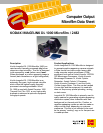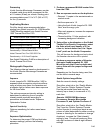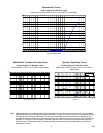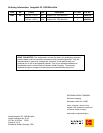
D-453
Processing
Kodak Komstar Microimage Processors contain
a heated metal drum which processes this film
at 1.8 meters (6 feet) per minute. Starting point
recommendations are 119 ± ½°C (246 ±1½°F)
for five (5) seconds.
Duplicating Masters
Print film density aims recommended when
printing from Kodak Imagelink DL 1000 Microfilm
/ 2482 Microfilm masters onto Kodak Premium
1000 Thermal Print Film 1323:
Kodak Premium 1000 Thermal Print Film 1323
Optimum background density 2.20
Preferred background density range 1.90 to 2.25
Minimum background density 1.80
Kodak Imagelink DL 1000 Microfilm / 2482 Microfilm
Densitometry = Diffuse Status M Blue
Kodak Thermal Print Film 1353/1323 Film
Densitometry = f/4.5 Visual Projection
See Kodak Publication D-49 for a description of
Kodak Thermal Print Films.
Photographic Properties
The following data are based on development in
the Kodak Komstar Microimage Processor as
recommended.
Exposure
Kodak Imagelink DL 1000 Microfilm / 2482 is
exposed inside a computer output microfilmer
using a helium-neon laser for characters and
a tungsten light or helium-neon laser exposure
for the forms slide.
The optimum exposure intensity setting is
determined by selecting from a complete
intensity series produced according to
procedures as indicated under Exposure
Optimization below.
Spectral Sensitivity
Optimum sensitizing for helium-neon lasers
(633 nm).
Exposure Optimization
To determine the proper COM and duplicator
exposure settings, perform the following
procedure:
1. Produce a processed BLANK master fiche
from the COM.
2. Run an exposure series on the duplicator.
Request 11 copies in the semiautomatic or
manual mode.
Set the exposure to 1.0.
Using the fresh Kodak Imagelink DL 1000
fiche, start the copy cycle.
After each exposure, increase the exposure
setting by 0.1.
There should be 11 fiche produced, with
increasing background densities.
3. Using either a densitometer or the Kodak
Thermal Print Density Comparator, select
the fiche which has a density of 2.2 or
close to, but not darker than, the Upper
Limit patch on the Kodak Comparator.
This will become the background onto which
the Komstar characters will be printed.
4. Produce an exposure series of Komstar
data onto Kodak Imagelink DL 1000
Microfilm such that it can be duplicated
onto a fiche with the proper background
density.
Depending on the Komstar being used, this
can be done in several ways.
Kodak Optistar Image Writer
Note the current intensity settings.
Run either a test job or the Quality Monitor
Test from the Optistar Systems Console.
Run the job several times and vary the
intensity up or down (in increments of 10)
each time.
Komstar 100/200/300 Microimage
Processors, Komstar Microimage
Processor IV, and Optistar Processor V
Run either a test job or the Quality Monitor
Test from the Optistar Systems Console.
As the Komstar is running and starts a new
column of data (determined by either counting
frames or listening for the camera to change
directions), increase the Data Intensity
setting by one. This should produce a fiche
with eight columns of data at eight different
settings.








